
Contrary to what countless digital marketing blogs might have told you, there’s no secret formula to getting landing page conversions.
There’s no magic CTA button color, no single headline formula that works every time, no ideal lead capture form length, and no main page pattern consistently brings in landing page conversions.
Converting visitors to leads or customers on landing pages depends on whether you can persuade them to click your CTA button and fulfill the conversion goal. The conversion goal can vary depending on the page offer. It can be collecting registrants for a webinar, getting $1 reservations for your newly launched product, or obtaining free trial sign-ups.
The primary purpose of your landing components, including the headline, form, copy, and call to action button, is to convince visitors to convert.
There’s one specific landing page element that transforms leads into customers while sending a trust signal and establishing credibility for the page and, by extension, your brand—social proof.
This post will delve into everything you need to know about social proof, starting with what it’s, the qualities that make it effective, and ways to include it on your landing pages, highlighted by real page examples. In addition, this will help you use the cognitive bias on your pages to convince visitors to perform the page action.
Let’s begin.
Effortlessly export your Google Docs to WordPress with just 1-click.
Get Started Today
Social proof is a cognitive bias and social phenomenon which dictates that people copy the actions of others in an attempt to undertake behavior in any given situation.
The social proof theory stems from the human need to conform. Social proof is embedded deep into our evolutionary code—we crave other people’s opinions, so we always look for them.
It’s the same need sheep have to stay with the herd and why TikTok trends go viral, with millions of users imitating the same dance routines. This can lead to a snowball effect, by tapping into our desire to belong and connect, TikTok and other social media platforms have created a powerful tool for building communities and fostering engagement among their users.
It’s why Gwyneth Paltrow’s modern lifestyle brand Goop is still in business, despite widespread criticism for marketing harmful products and scientifically questionable treatments.
Psychologist Robert Cialdini first popularized the social proof theory in his 1984 book Influence. It’s one of six principles of persuasion, and according to Cialdini, the theory maintains that:
“A person who does not know the proper behavior for a certain situation will look to others to imitate what they’re doing and provide guidance for his actions.”
Visitors who land on your page are probably unfamiliar with your brand and offer. They’re unsure whether to trust you with the information they’ve entered in the lead capture. Whether a visitor is going to purchase an expensive watch or subscribe to a virtual scribe service, social proof can help them feel confident about the commitment they’re about to make. Social proof helps visitors feel reassured about the commitment they’re about to make. When they see other people have had faith in your offering, they’re more confident about doing the same.
Social proof on your landing page translates into using positive customer experience to showcase why prospective customers should take advantage of your offering. For example, just because you’re offering a free trial doesn’t automatically translate into every page visitor taking up your offer. To increase the chances of engagement, it’s also important to improve page loading speed, as delays can cause visitors to leave before seeing the value of your offer or the social proof that supports it.
Even though the trial is free and no money is involved, it’ll still require users to spend time and effort. You then need to persuade users that the free trial benefits them. Showcasing what other free trial users gained from your service is crucial to getting visitors to commit to your offer. For instance, remote medical scribe companies often share physician testimonials to show how their service improves clinical documentation and saves time.
Another great example is using a prior authorization virtual assistant, especially for healthcare providers dealing with insurance approvals. Including testimonials from clinics or physicians who have reduced administrative burden with this service can act as powerful social proof on your landing page.
In similar situations, you can opt for a virtual medical assistant to handle administrative tasks, and reinforce that choice with testimonials from professionals who’ve benefited from the service. Show testimonials and evidence to prospective customers that previous ones approve of your product/service and share reasons why. Show testimonials and evidence to prospective customers that previous ones approve of your product/service and share reasons why.
The cognitive bias works on the following mechanisms.
Now that we’ve discussed what social proof is and why it works, let’s look at how to use it on your landing pages.
There’s no “right” or “singular” way to include social proof on your landing page. You can feature it in all the methods described below, or choose the ones that best suit your offer and brand.
Short quotes from satisfied customers can do wonders for your advertising conversions, so it’s no surprise that this is one of the more prevalent uses of positive social proof.
Northwestern University’s Spiegel Research Center analyzed ratings and reviewed data from an online retailer of expensive gifts to test the impact of customer reviews on conversion rates. Based on their analysis, conversion rates escalate rapidly as products begin displaying online reviews.
The purchase likelihood for a product with five reviews is 270% greater than that of a product with no reviews.
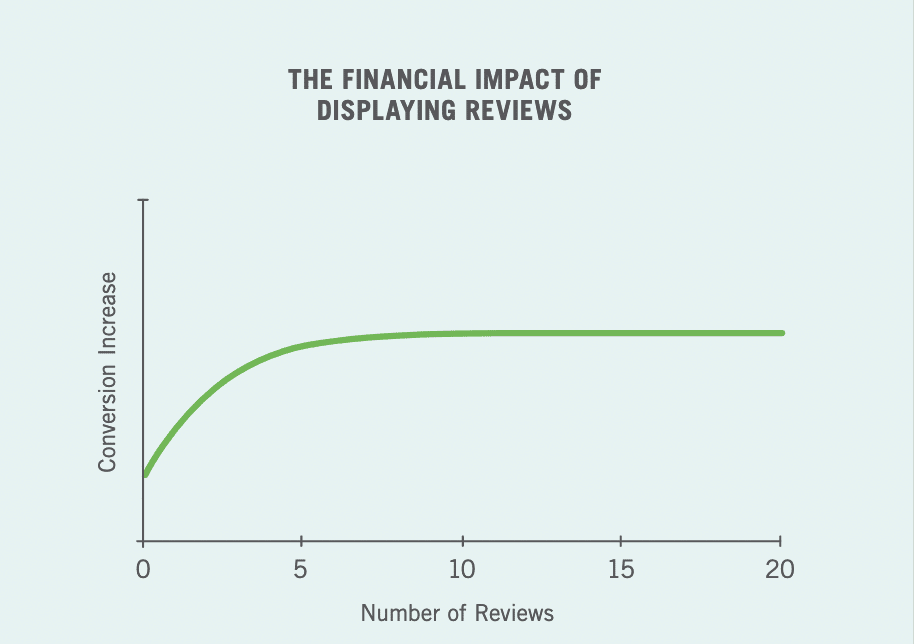
You can boost the credibility of customer stories by including a photo, name, company, job title, and quote. To optimize your page quotes, it’s best to add anecdotes that explain how your offer alleviated the customer’s pain and brought them joy.
Feature social reviews anywhere on the landing page and A/B test to see which placement works.
BenchmarkONE showcases a customer testimonial that discusses the exact results the customer achieved with their email marketing and CRM tool. This helps future clients envision similar results and increase the chances of opting in for the live demo.
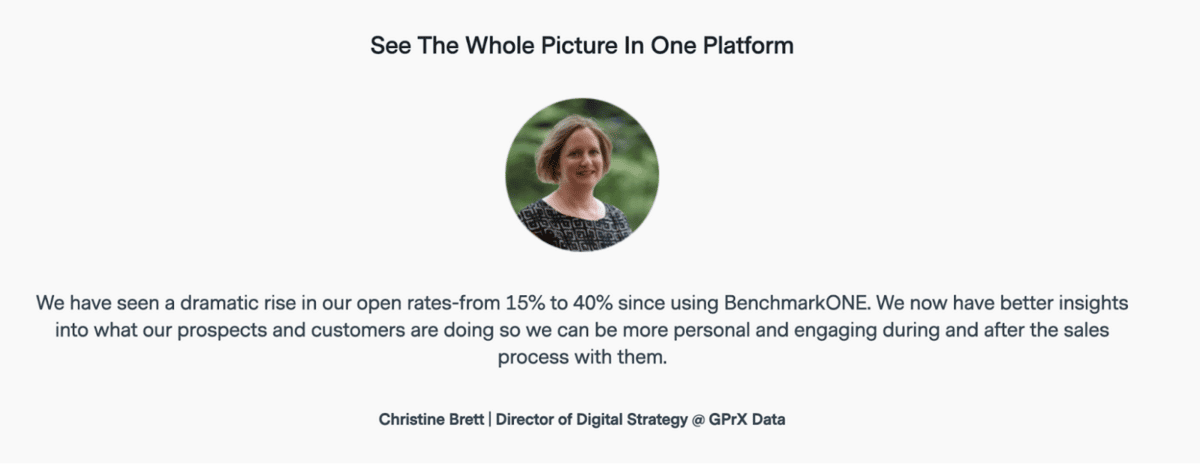
Pluto features star ratings alongside each review to get new users to understand why they should buy a Pluto pillow. One positive review even talks about how the Sleep Cycle app picked up Pluto pillow’s efficacy.
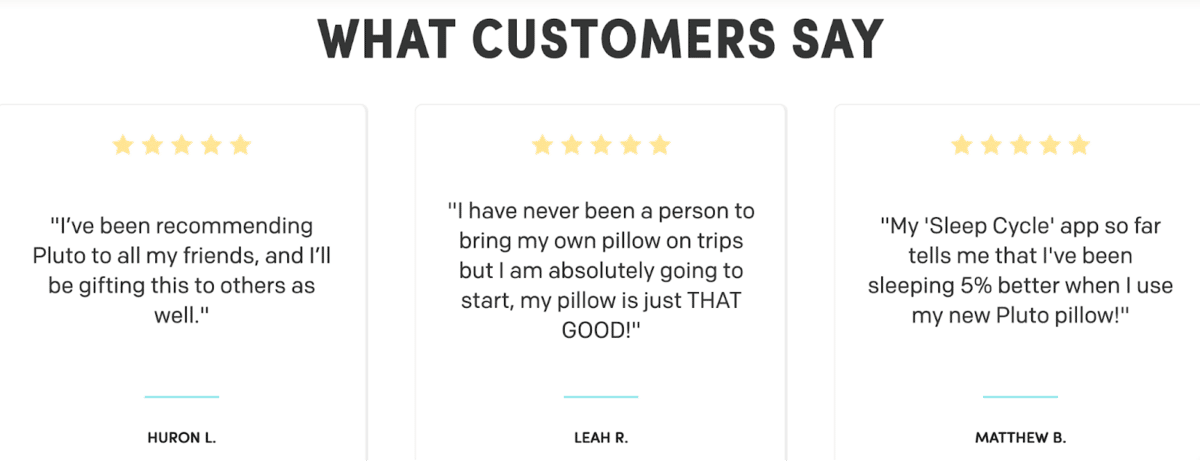
A customer counter works in the same principle as the herd behavior: People follow others instead of using their knowledge to make independent decisions. Most people go along with the crowd instead of paving the way themselves.
When you include the number of customers you currently have on your landing page, it signals to visitors that people have already placed their trust in you. This positively influences their decision-making.
Intercom features page copy “Trusted by 25K+ customers” to signal new visitors that they will join a robust community when they decide to “view demo.”
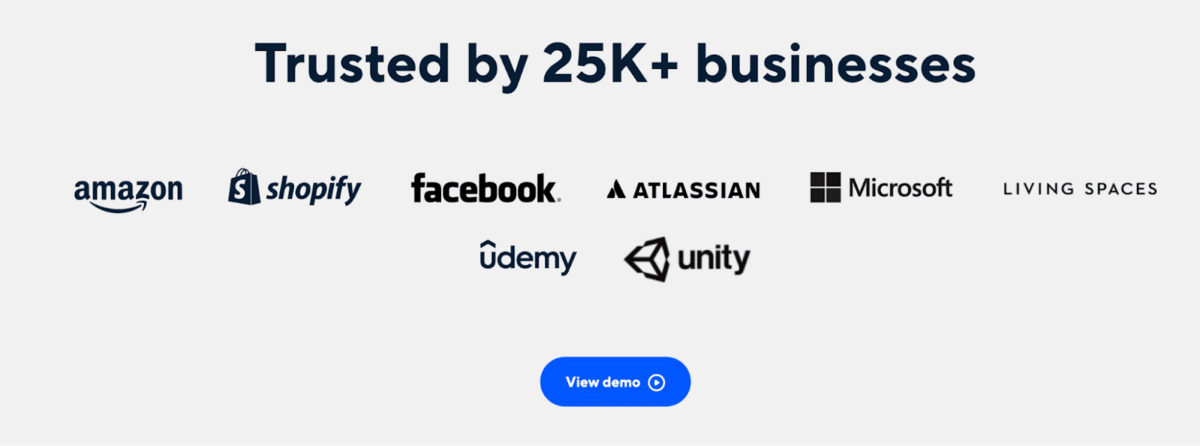
Customer logos help establish credibility for the same reason celebrity endorsements and influencer marketing do. Using well-known brand logos amplifies the persuasion effect.
People generally have a positive association with well-known brands. When they see that those big brands are using your service, people are more likely to view your brand more positively.
Smartsheet’s landing page features LEGO, P&G, Pfizer, NASA, and American Express logos.

Sendinblue uses customer badges from renowned brands such as BMW, MICHELIN, and Amnesty International to show customers that big brands choose the email marketing software over their main competitors.

Third-party reviews work for two reasons. First, they’re objective. Instead of singing your company’s praises, an independent brand or review site agrees that you can fulfill your promises. The second is another example of the intuitive herding mentality. When other brands rate you favorably, it helps future customers realize the value in your product or offer, which leads them to click the CTA button.
Jasper, the AI writing tool, uses user reviews and ratings from credible review websites like Capterra, G2 Crowd, and Trust Pilot to inform customers how successful their tool is for marketers, writers, and entrepreneurs.
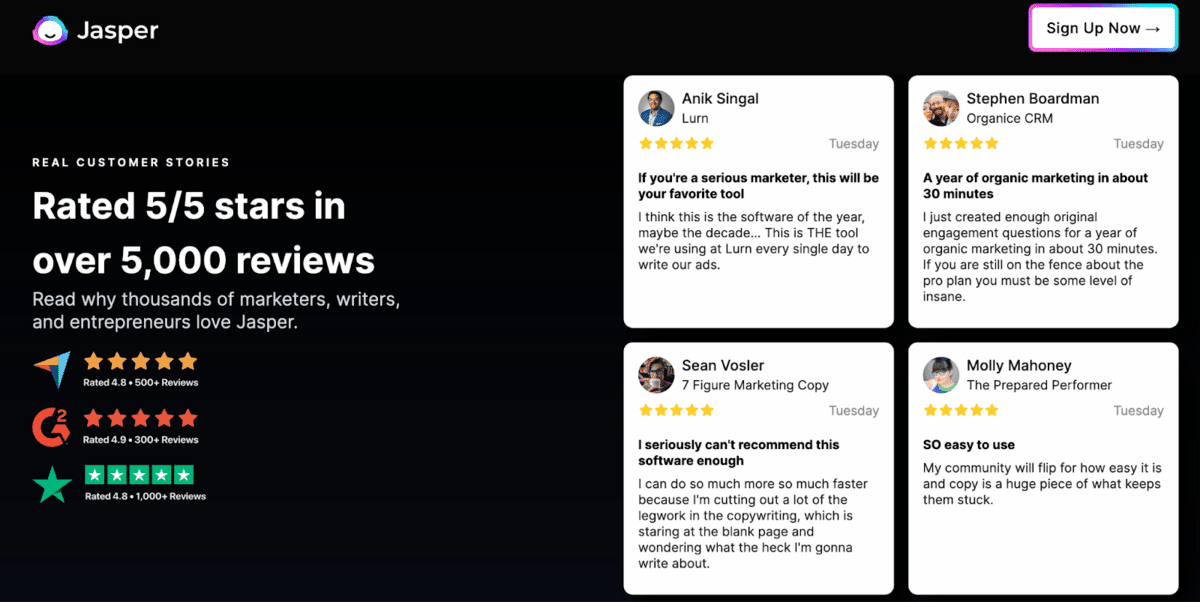
Toggl, an easy powerful time tracking tool, uses Top Rated and Top 100 badges from G2 crowd and a “Software Leader” award from Crozdesk on the page along with the user count five million+ who use the tool to track their tasks.

Visitors feel reassured about filling out landing page forms when they know the company they’re submitting their information to won’t use it for purposes other than what they promised.
Think of trust badges as website security seals of approval. Common trust seals include SSL certificates, VeriSign Trusted seals, safe checkout badges, Norton, and payment logos like Visa or Mastercard.
Another way to encourage visitors to enter their data on your landing page form is to add a link to your privacy policy on the page. The policy should detail how you plan to use their information and specify that you won’t sell their data to other websites or advertisers.
Press reviews are an excellent way to inject credibility into your landing page and kick in the benefits of social proof. When users come to a page and see favorable press reviews, they feel more confident about the efficacy and advantages of the product/service and are more likely to click the call to action button. You can even add them into your press release templates.
Curie, the all-natural deodorant stick brand, features press reviews by Allure, InStyle, and Well + Good to showcase to new users why they should use Curie and what the deodorant stick smells like.
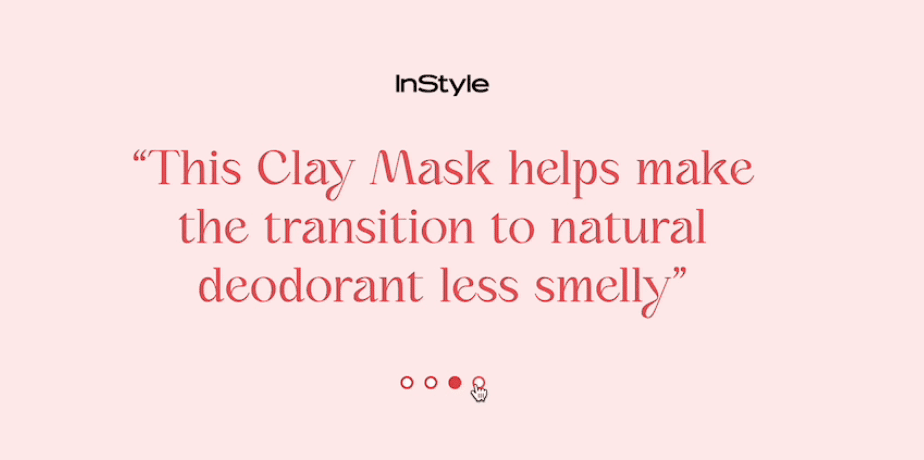
Pluto pillow uses press reviews from Fast Company, Wall Street Journal, Cnet, and Futurism to explain why they need the customizable pillow to get the perfect night’s sleep.

Creating high-converting landing pages involves more than throwing a bunch of elements on a page, hoping visitors will find it relevant and click the CTA button.
The process requires optimizing every page element and connecting the audience with narratives that persuade them to convert. Social proof helps you do both—it forms a connection with your audience with relevant records.
Social proof helps establish credibility for your offer and, by extension, your brand. By adding positive social proof elements to your landing page, including customer reviews, quotes, badges, counters, third-party reviews, and trust seals you signal to new visitors coming to the page that customers who have used your product have found it valuable and beneficial.
Converting your visitors is all about getting them excited about the offer and trusting your brand—social proof accomplishes both of these, making it more likely for you to get conversions.